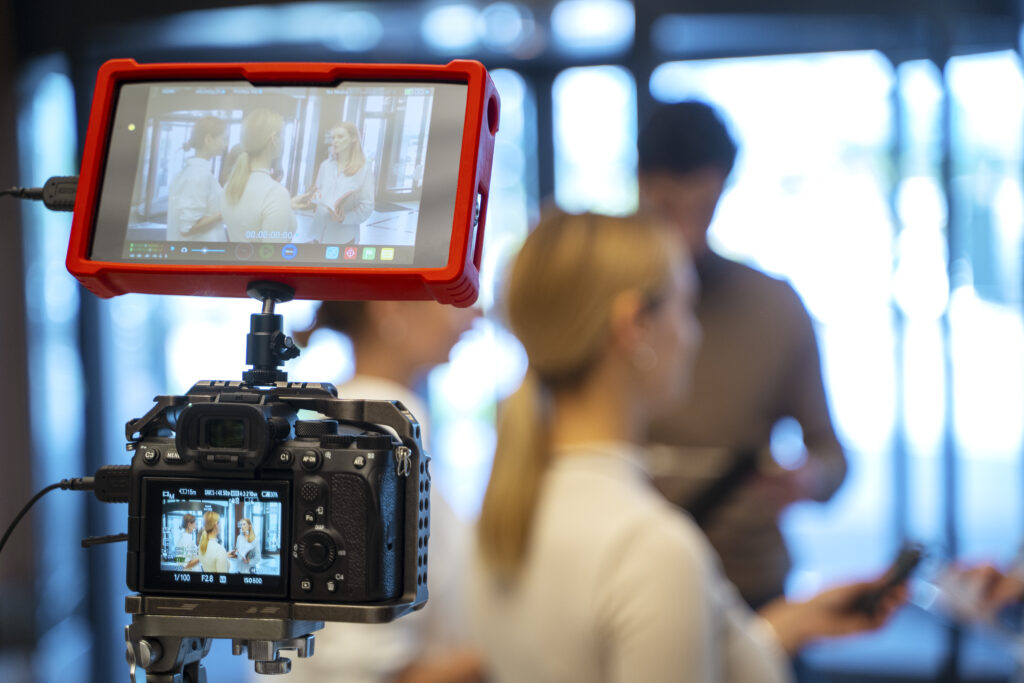Short-form video is taking over B2B video marketing in 2025 and it’s easy to see why. These quick, engaging clips grab attention, deliver value fast, and connect with professional audiences in a way other formats can’t. If your B2B brand isn’t using short-form video yet, you’re missing one of the most effective ways to boost awareness, generate leads, and stay top of mind with decision-makers. Let’s look at why it works, what to post, where to share it, and how to start today.
When short-form video started
Short-form videos are clips under 90 seconds that deliver a clear message quickly. Their rise began with platforms like:
- Vine – launched in 2013, now discontinued but an early pioneer.
- TikTok – launched in 2016 (as Douyin in China, TikTok globally in 2018).
- Snapchat – started with disappearing messages in 2011, later added short video Stories.
- Instagram Reels – launched in 2020.
- YouTube Shorts – launched in 2021.
73% of marketers say video has helped them achieve business goals like boosting sales or brand awareness¹. However, 37% of marketers haven’t started using video because they don’t know how to begin². If that’s you, don’t worry this guide will make it simple to get started
Why businesses should consider short-form video for their B2B video marketing?
- An opportunity to tell a different (more human and authentic?) kind of story: Short form content are so different by nature from long-form content that they don’t have to play by the same rule (like corporate branding and storytelling), they are great to put a human face on your business and use humour for example. Short-form is a place to experiment, perfection is not required.
- Increase brand awareness: Quick videos introduce your brand to new audiences in a memorable way. Their viral nature make it easier to get views beyond your typical reach.
- Great to introduce a new audience to more complex content. B2B should be able to deliver complex narratives, that’s not always possible in 20sec. However short-form content are great for teasing your long-form content with highlights and redirect them to the longer content. They are also useful to deliver bit-sized knowledge, like demystifying complex part of your business.
- Good value for bucks: Short-form videos are relatively cheaper to make as viewers are used to “imperfect home-baked” video style. Due to their viral nature, they are likely to perform well in advertising, delivering your reach and brand awareness at a cheaper rate than the long-form content.
- Community and engagement: Because B2B short-form content are less “pretentious” and easier to understand than long-form expert content, they are great to gather interactions and engagements: likes, shares, and comments. This will make your content reach further and help you build a community.
What B2B marketers should know
To make short-form video work, you need to grab and hold viewers’ attention instantly… within the first three seconds! A strong hook such as a surprising fact, bold question, or quick visual can be the difference between someone scrolling past or stopping to watch. Effective short-form videos deliver their message quickly to match short attention spans, focus on one clear idea to avoid overwhelming viewers, and use engaging elements like visuals, music, or humor to keep people watching.
What types of B2B video marketing work best for B2B?
- Educational
Share tips, product explainers, or how-to guides. For example, a 30-second clip showing how your software saves time can attract busy professionals. - Trendy
Jump on viral challenges or trending topics, but keep it relevant to your brand. For instance, a B2B tech company could use a trending sound to highlight a new feature. - Engaging
Create relatable or fun content, like behind-the-scenes looks at your team or lighthearted takes on industry challenges.
Where should B2B brands publish short-form video?
Most used B2B video platforms (according to Wyzowl 2025) include LinkedIn, Facebook, Instagram, and Webinars.
LinkedIn is perfect for professional audiences and thought leadership content, favoring polished and educational video clips.
Facebook excels at community building and retargeting ads.
Instagram is ideal for visually appealing Reels that showcase a brand’s personality with creative and eye-catching visuals.
Webinars provide engaged prospects opportunities to repurpose clips into short videos for social media or email campaigns. Although webinar are usually long-form content, the most instructive and fun moments can easily be extracted to create shorter video bits, it’s usually a good place to start and will allow you to repurpose older video content.
Each platform has unique strengths, so tailoring video content to fit the platform is essential.
Tips for creating short-form video
- Ideal length: Most marketers agree 21–60 seconds works best. Aim for around 30 seconds to keep it short and clear.
- Storytelling: Grab attention in the first 3 seconds with a question, bold statement, or strong visual. Then deliver a clear, focused message.
- Focus on quality: Use good lighting, clear sound, and sharp video. Tools like Adobe Premiere Rush or Instagram’s editor help make editing easy.
- Stay Relevant: Use trending topics or sounds only if they fit your brand’s voice.
- Add Captions: Many viewers watch without sound, so include captions to make your message clear and searchable.
Example of a B2B short video

A great example is Zendesk’s Instagram and TikTok videos. They create short, engaging clips featuring real employees explaining customer service tips in a conversational style.
These videos use captions, bold visuals, and a friendly tone to make complex topics feel approachable. For instance, a 30-second clip might show an employee sharing “3 Ways to Handle Customer Complaints” with text overlays and upbeat music, ending with a call-to-action to visit their site.
Text-overlay and captions are great as they make your video accessible even to users that are not listening to audio, as it’s often the case with people consuming video on the go from their smartphone.
This approach works because it’s relatable, educational, and optimized for silent viewing, making it perfect for busy professionals scrolling on their phones.
How B2B can start short-form video today
- First, set clear goals like raising brand awareness, getting leads, or boosting engagement.
- Next, know your audience, think about who you want to reach, such as CEOs or IT managers, and what they care about. Then, plan your content by picking a style (like educational or fun) and write a short script with a strong opening.
- Use simple, free or cheap tools like Canva, Adobe Premiere Rush, or the editors in Instagram and TikTok to create your videos. Although it’s important to keep some part of your corporate branding, remember that this is a “fun” format that doesn’t need to feel as “polished” as your typical corporate video content. It’s “imperfectness” combined to the front-facing “influencer” are what makes it authentic.
- Make sure your videos are vertical for phones and add captions so everyone can understand.
- Post your videos on LinkedIn, Instagram, or other platforms and reply to comments to connect with viewers. Finally, check your video’s views, likes, and shares to learn what works and improve.
- Start with one video a week and grow from there as you get more comfortable.
Future trends and predictions for short-form video in B2B marketing
Short-form video is growing fast and will be even bigger in 2025. Expect AI tools like smart editors and auto-captioning to make videos easier and cheaper to create. Interactive features such as polls, quizzes, and shoppable videos will help boost engagement. B2B audiences will want authentic, real stories instead of polished ads. Platforms like LinkedIn, Instagram, and TikTok will keep leading the way for B2B video content. To stay ahead, start now by making one short video, posting it on LinkedIn or Instagram, and watching how your audience reacts. With practice, you’ll create videos that catch attention, build trust, and get results for your B2B busines
For more insights on building digital authority in B2B, explore these articles:
- Answer engine optimization (AEO): Why B2B brands must adapt to AI-driven search
- Instagram SEO indexing: What it means for B2B in 2025
- E-E-A-T for B2B businesses: how to build website SEO credibility
Ready to elevate your B2B manufacturing SEO strategy and succeed in the digital landscape?
Last updated on:
Sources




